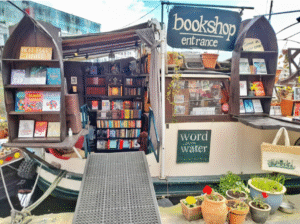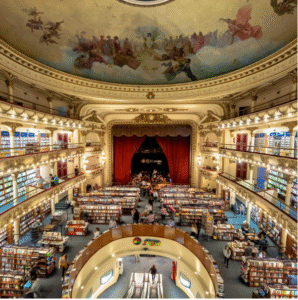By Jeremy Liddle, Managing Director of Third Hemisphere, a full service marketing, PR, and public affairs agency with offices in Sydney, Melbourne, Singapore, HK, the US, EU, and UK
The creative industries are discovering innovative revenue generation models through literary-focused venues that successfully combine content creation, live programming, and experiential services. Global research involving 200,000 consumer preferences across 54 international destinations reveals how creative professionals and cultural enterprises are building sustainable business models that integrate multiple creative disciplines within physical spaces.
The findings demonstrate significant opportunities for creative practitioners, content creators, and cultural entrepreneurs seeking diversified income streams beyond traditional publishing, performance, or media production models. These venues showcase how creative programming can generate consistent revenue while building engaged audiences and supporting local creative ecosystems.
The comprehensive data provides valuable insights for creative industry professionals examining sustainable business development strategies that leverage both digital marketing capabilities and authentic physical experiences. The research indicates that successful creative enterprises increasingly require hybrid approaches combining online promotion with in-person programming and community engagement.
Creative programming strategies generate diversified revenue streams
The most successful literary venues demonstrate sophisticated creative programming approaches that generate multiple income sources while building sustainable audience relationships. These establishments prove that creative content can drive commercial success when integrated with hospitality services, retail operations, and community programming that encourages repeat engagement.
Boekhandel Dominicanen hosts cultural events including readings and live music performances within its converted Gothic church setting, creating premium experiences that command higher pricing than traditional retail transactions. The venue’s historic architecture provides a distinctive backdrop for creative programming that attracts both local audiences and cultural tourists seeking authentic experiences.
Shakespeare and Company maintains consistent literary events programming that complements retail operations while building ongoing relationships with writers, readers, and literary enthusiasts. This programming strategy demonstrates how venues can support creative practitioners through performance opportunities while generating additional revenue streams beyond book sales.
Word on the Water operates live music, poetry readings, and writing workshops from its London canal barge location, proving that creative programming can succeed in unconventional venues with lower overhead costs. The floating bookstore model reduces property expenses while creating unique programming opportunities that differentiate creative offerings from mainstream entertainment options.

Event programming revenue analysis indicates venues hosting regular creative events demonstrate superior consumer engagement metrics compared to retail-only operations. Extended operational schedules support diverse programming requirements, with venues like Minoa Pera extending weekend hours to midnight to accommodate cultural events alongside retail operations.
Creative collaboration opportunities emerge through venues that support multiple artistic disciplines simultaneously. Multi-service integration allows creative professionals to cross-promote services while sharing operational costs and audience development efforts. This collaborative approach creates sustainable business models for individual creatives while building stronger cultural programming for venues.
Content creation and social media integration drive audience development
Successful literary destinations demonstrate innovative approaches to content creation and digital marketing that amplify physical programming while building online audiences. These venues utilise social media strategies that document authentic creative experiences rather than manufactured promotional content, creating genuine audience engagement that supports both online and offline revenue generation.
Dujiangyan Zhongshuge creates naturally Instagram-worthy environments through innovative design featuring mirrored ceilings and curved bookcases, but the visual impact serves functional purposes of encouraging extended exploration and creating infinite literary impressions. This approach demonstrates how creative spaces can benefit from social media amplification while maintaining authentic programming focus.
Visual content creation opportunities abound in venues with distinctive architectural features. El Ateneo Grand Splendid’s 1919 theater conversion provides ornate viewing boxes and painted dome ceiling that create compelling backdrops for creative content while serving functional roles as reading spaces and café areas. Trinity College Dublin’s Long Room offers similar content creation opportunities within authentic scholarly environments that attract both academic and general audiences.

Creative partnerships with content creators and influencers emerge through venues that offer authentic programming experiences worth documenting and sharing. Rather than paying for promotional content, successful venues create genuine experiences that content creators voluntarily share because of intrinsic value and visual appeal.
Digital marketing strategies focus on promoting in-person experiences rather than replacing them with online alternatives. Venues utilise social media to build anticipation for live events, document authentic programming experiences, and maintain community connections between physical gatherings. This approach creates sustainable audience development that supports long-term revenue generation.
Alternative content creation approaches include venues like Péniche L’Eau et les Rêves, specializing in botanical publications while creating greenhouse-like interior environments that naturally generate compelling visual content. The venue’s canal location and plant-focused design create distinctive content opportunities that align with niche audience interests while supporting specialized programming.
International creative economy models reveal expansion opportunities
Geographic analysis of successful creative programming venues reveals diverse approaches to cultural enterprise development across different economic and regulatory contexts. European markets demonstrate mature creative industry infrastructure supporting literary venue development, while emerging markets show significant potential for creative economy expansion through similar business models.
European creative industry success includes venues in Netherlands, France, UK, and Portugal that demonstrate established policy frameworks supporting cultural commercial development. Multiple historic building conversions across European markets suggest favorable regulatory environments for creative enterprises seeking distinctive programming venues with reduced property acquisition costs.
International creative collaboration opportunities emerge through venues that attract both local and international audiences. Minoa Pera houses 45,000 titles in Turkish and English while hosting cultural programming that serves diverse creative communities, demonstrating how literary venues can support cross-cultural creative exchange while building sustainable local operations.
Creative industry development patterns show concentrated success in specific geographic regions that provide strategic guidance for creative entrepreneurs examining international expansion opportunities. Asia-Pacific territories show limited representation despite substantial creative industry growth, suggesting significant market development potential for literary venue concepts adapted to local creative contexts.
South American creative industry examples include multiple venues across Argentina, Brazil, and Mexico that demonstrate successful regional creative programming models. Cafebrería El Péndulo operates two-level configurations supporting diverse creative activities from morning writing sessions to evening literary events, while Eterna Cadencia combines bookshop operations with creative programming in outdoor patio settings.
Australian creative industry performance demonstrates strong market receptivity through venues like State Library Victoria and Ampersand Café & Bookstore that successfully integrate creative programming with community services. These examples suggest significant potential for creative industry development in English-speaking markets with established cultural tourism infrastructure.

The 1000 Libraries research demonstrates that creative industry enterprises can achieve financial sustainability while supporting diverse creative practitioners through integrated programming approaches. Revenue diversification strategies proven across international contexts offer replicable frameworks for creative entrepreneurs seeking sustainable business development.
Consumer behaviour data indicates strong international demand for authentic creative experiences that combine programming quality with distinctive venue character. Historic architecture commands measurable consumer preference premiums, suggesting creative enterprises can benefit from distinctive venue selection while supporting heritage preservation through cultural programming.
Market expansion opportunities appear particularly promising in regions with developing creative industries but limited authentic cultural venue infrastructure. The research provides evidence-based guidance for creative industry development that addresses community cultural needs while generating sustainable income streams for creative practitioners.
For creative industry professionals examining sustainable business development strategies, the 1000 Libraries findings provide quantitative validation for programming approaches that integrate multiple creative disciplines within distinctive physical spaces. The data supports investment in creative venue development that serves both artistic and commercial objectives while building engaged creative communities.

